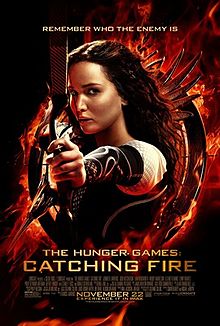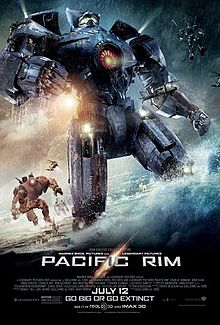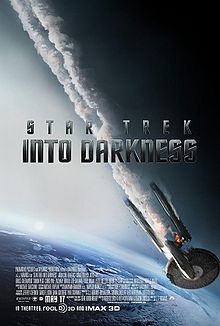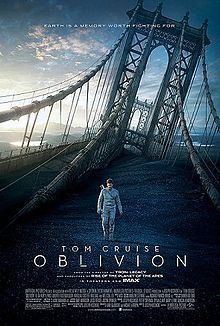Science-Fiction films - 2013
| The Hunger Games: Catching Fire | Pacific Rim | Star Trek Into Darkness |
| Oblivion |
____________________
 |
The Hunger Games: Catching Fire is one of the rare sequels that spectacularly improves upon its predecessor. Under the guidance of a new writer (Michael Arndt - Toy Story 3, Little Miss Sunshine) and director (Francis Lawrence – I Am Legend), the film skips what could have been a slow exposition and hits the ground running. While the games don’t begin until roughly halfway through the movie, the lead-up is spent giving us fascinating insight into the budding rebellion sparked by Katniss and Peeta’s defiant stunt at the end of the previous year’s Hunger Games—and the Capitol’s ruthless efforts to suppress it. In the process, we delve much deeper into the themes explored in Suzanne Collin’s books, which many rightly complain were elided by the original movie.
Setting the tone for the film is Katniss’s first extended interaction with Donald Sutherland’s chilling President Snow, where we learn that the victors are being monitored just as closely as they were in the games, and that their lives—and the lives of their loved ones—still depend on their ability to present a convincing, Capitol-approved face to the public. Having already narrowly escaped sacrificing her life to protect her family, Jennifer Lawrence’s war-weary Katniss now faces constant scrutiny and ever-present surveillance with admirable strength and human vulnerability, fully aware that the slightest misstep could be fatal to herself, her loved ones, or even the newly emboldened citizens of the oppressed districts. The pressure mounts as we follow Katniss and Peeta on their “Victory Tour” through the districts, where in spite of their best efforts to the contrary, they are greeted as symbols of defiance and hope, provoking brutal responses from government-appointed Peacekeepers.
Where the conclusion of the first games set up what seemed like a potentially happy ending for the two victors, Catching Fire makes it abundantly clear that, as Woody Harrelson’s Haymitch tells Katniss on their way to the Victory Tour, “You never get off this train.” Even survivors of the Hunger Games never entirely stop playing. Living out their lives under the Capitol’s watchful eye, their survival and the safety of their families depends on a constantly flawless performance. The story foregrounds tension between personal survival and political justice: Is Katniss’s responsibility to protect her family, her district, and herself? Or does her status as a reluctant symbol of a brewing revolution obligate her to a higher cause, even at the risk of lives and safety? As Katniss grapples with these questions, her relationships with other characters, particularly Peeta and Gale, take on a deeper dimension than what we saw in the first movie. In her struggle to protect loved ones, she even finds that some of them—including Gale, Prim, and others—even resist, preferring to stand in solidarity with the rebellion she has started. Meanwhile, a bond of mutual protection persists between Katniss and Peeta, but assumes more depth and realism as we gain an understanding of their unique shared burden, including the trauma incurred during the previous games and their continued state of danger and obligation.
Adding further gravity to the Hunger Games’s second installment is Phillip Seymour Hoffman’s performance as the new Head Gamemaker, Plutarch Heavensbee. The films differ from the books in making viewers privy to the conversations each Head Gamemaker has with President Snow. However, whereas the first Head Gamemaker, Seneca Crane, was shown being schooled by the president in the sinister strategies behind the Capitol’s dominance over the districts, Hoffman’s Heavensbee plays a slyly knowing, down-to-earth Gamemaker, calmly adept at manipulating public relations. Where Crane was shown to be easily swayed by both President Snow and District 12 sponsor Haymitch Abernathy, Heavensbee always has a clear and convincing plan, persuasive even to President Snow. Lacking the ostentatious dress and behavior of Capitol residents like Crane, Caesar Flickerman, and Effie Trinket, Hoffman’s understated performance also lends much needed dignity and mystery to the Capitol’s scenes.
Finally, I would be amiss if I didn’t mention the 75th annual Hunger Games themselves. With a new director, the deplorable shaky-cam used in the first film is gone, with tension instead created through the presence of a deadlier arena, scarier, more seasoned adversaries, and the performances of a talented cast of tributes. The same tensions present in the first film—over survival, alliances, betrayals, and protecting friends when there can be only one survivor—are all present to a heightened degree, for reasons that I will exclude to avoid undue plot spoiling. While wounds and gore appear only sparingly, a liberal dose of unpredictable menaces—with the arena this time serving as a larger threat than the other tributes—along with convincing performances, particularly from Jennifer Lawrence, make this Hunger Games a nail-biting experience.
Fans will be pleased to see dialogue lifted directly from the book in crucial moments, along with subtly significant directorial choices such as a close-up on President Snow’s gruesomely reddening drink as he toasts the victors at a celebration in the Capitol. Those not familiar with the books should be pleased with the heightened pace, raised stakes, and deeper exploration of significant themes, including trauma, loyalty, love, manipulation, and above all, responsibility.
Hopefully this superior installation in the series is a sign that we can look forward to the upcoming two-part Mockingjay movie, rather than dreading its now-conventional choice to unnecessarily split its events into two movies in a “soich for more money”—as Spaceballs’s Yogurt would call it. A successful finish will help solidify The Hunger Games’ place as a classic—an intelligent young adult sci-fi adventure series centered on a strong female protagonist tasked with using her courage, strength, and skill to protect her loved ones and maybe even topple a totalitarian government along the way.
- Kathryn Carty
____________________
 |
Pacific Rim is, simply put, an application of the current state of movie special effects to the genre of giant monsters and giant robots. With cgi graphics as good as they are now, what can't be depicted on the big screen anymore? But as fabulous as the effects may be, you can't expect people to sit through two hours of giants facing off. So, we do have a plot. The giant monsters (Kaiju) appearing out of nowhere (a dimensional rift at the bottom of the Pacific ocean) are threatening humanity's continued existence. Conventional weaponry was effective for a while, but eventually something greater was required, thus the Jaegers - giant nuclear-powered robots with mechanized and energy-based weaponry - were created. The Jaegers are piloted by a neural interface to a human pilot. To make things more interesting, the neural interface is too demanding for a single human being, so they are made by two or more pilots together. While mentally connected to the machinery this way, the pilots are also mentally connected to each other, sharing thoughts and feelings. (Talk about working closely with someone.)
But when people buy their tickets to see this film, they are not thinking about characters or sci-fi plot elements. They are expecting to see giant robots fighting giant monsters. So how does the film deliver on this? I think it's fair to say they knock this out of the park. The generated imagery of the Jaegers vs. the Kaiju in water and urban battlegrounds was pretty awesome. People got their money's worth.
What about the rest of the movie? The characters are mostly stereotypes - the veteran warrior haunted by the past pulled back into the fray; the tall, deep-voiced authority figure who drives everything and everyone; the talented ingenue who is also haunted by a traumatic past; the cocky egotistical jerk; the wild-haired "mad" scientist; the fastidious fussy scientist; the shady crook; stereotypical russians and stereotypical asians. The convenience of using a stereotype is that you can introduce a character of such a type and the audience, to a large extent, knows who this person is. This is useful in movies where the story-teller only has a few hours to get everything across and there are so many characters. However, the characters themselves are less interesting than their interactions.
Human beings are interesting creatures. They are at once social and anti-social. People need contact with others to stay sane and give their lives meaning. But we are also territorial and exclusionary. We want to be connected, but only to those we know, trust, and feel mutual respect with. In Pacific Rim, as in Independence Day, we are all in this together or else we can share extinction together. The director, Guillermo Del Toro, was quoted as saying, "The pilots' smaller stories actually make a bigger point, which is that we're all together in the same robot [in life]... Either we get along or we die. I didn't want this to be a recruitment ad or anything jingoistic. The idea of the movie is just for us to trust each other, to cross over barriers of color, sex, beliefs, whatever, and just stick together." Del Toro acknowledged this message's simplicity, but said he would have liked to have seen adventure films with similar morals when he was a child. "I think that's a great message to give kids... 'That guy you were beating the shit out of ten minutes ago? That's the guy you have to work with five minutes later.' That's life... We can only be complete when we work together."
Pacific Rim is mostly just a good time at the theater with cool special effects and a plot and characters interesting enough to keep the viewer involved. Because of the visuals, don't wait to see this on the small screen. You will cheat yourself of the "bigness" and that is just too much of what this movie is about.
- Swift
____________________
 |
The history of creator Gene Roddenberry's Star Trek universe in film has been both extensive and diverse. The first ten films featured the casts from the popular television series, Star Trek (films 1-7) and Star Trek: The Next Generation (films 7-10). The eleventh film and reboot of the original characters, but with new actors in an altered timeline - Star Trek (2009) - was something of a game changer. JJ Abrams' re-imagining of that universe breathed new life into the franchise and now he brings us Star Trek Into Darkness.
The film open with Michael Giacchino's majestic score which echoed in my ears the rest of the day. We rejoin the Enterprise crew in mid-mission on an alien world. They have come to know one another better and have settled into their roles on the Enterprise. But some matters are still unresolved - Kirk's recklessness, Spock's adherence to the letter of the law, and the relationship between the two men. A terrorist threat sends a troubled crew into dangerous territory where they find out that a number of things were not as they had been led to believe.
With Abrams' first Star Trek film, I wasn't sure if I was onboard. I retained a lot of loyalty to the original TV series, its mythology, and the cast. Chris Pine's Kirk seemed like a narcissistic smart-ass - junior-officer material at best. Quinto's Spock was a martinet with occasional emotional outbursts, without the brooding presence or the deep voice of Leonard Nimoy. But the remainder of the supporting cast was excellent and the prospect of more big-budget Star Trek films was tantalizing. I hoped for the best and that the new spate of superhero-based movies wouldn't keep the studio from returning to the Enterprise and her crew. We should all be glad they came back.
Star Trek Into Darkness is an attempt to make Star Trek competitive with the other thrill-ride type blockbusters, but also retain the qualities that make Star Trek what it is. Good science fiction isn't just about what-ifs in technology. It's about how it relates to the human condition. In Trek lore in particular, it specifically relates to themes of fairness, justice, respect for the diversity of others, self-restraint, compassion, duty, loyalty, courage, self-sacrifice, and friendship. (Those are just the ones I can think of.) It's human beings trying to retain the best of their humanity in often times the worst and most unpredictable of situations. In spite of their quirks, you would be lucky to have any member of the Enterprise crew in your family. When I think of human evolution, I care less about increasing our physical prowess, intelligence, or life spans than that we simply could become better people.
Good science-fiction usually has elements of a mystery and Into Darkness doesn't disappoint on that count either. There are questions all the way through as to identities and intentions. There are also multiple instances where our heroes are placed in predicaments where one sits there thinking "how the heck are they going to get out of this one?" Yet they do, with a combination of guts, ingenuity, luck, and plot points that one may or may not think of as the story unfolds.
The story also manages to put emotional impact into its scenes. I won't spoil anything for those who have yet to see the film, but there are a couple of moments when it might be difficult to maintain a dry eye. And there is a chase scene where you too may want to pick up your phaser and kick someone's ass.
I found Star Trek Into Darkness a significant step up from its predecessor. It was more exciting and the development of the primary characters was much better. This story essentially makes Kirk and Spock into the characters they needed to be for the series to continue. May it live long and prosper.
- JC
____________________
 |
The odd truth about good science-fiction is that in spite of the machinery, the creatures, and the intricacies of time and space, these stories are really about the human condition. This film reminds us of this and does the job nicely in the first significant big sci-fi release of 2013.
Oblivion is the brainchild of Joseph Kosinski, who originally wrote it as a graphic novel and then co-wrote, produced, and directed the film. His previous directorial work was the film Tron: Legacy (2010). The film also stars Tom Cruise, who has appeared in a few films over the years . . .
This film starts as a mystery, another trait of many good science-fiction stories. Jack Harper (Cruise) is a futuristic tech, who with the assistance of his dispatcher, Victoria, flies around a desolate post-apocalyptic Earth in a bubble-like aircraft repairing droids. We get to struggle a while to piece together who these two people are, what happened to the world, why all the guns, and how did Tom Cruise wind up a computer repairman. We are later informed that there had been an alien invasion which laid waste to the Earth. Humanity had survived and mostly repelled the invaders, but a few aliens remained on Earth and the flying-armed droids - "drones" - are programmed to seek and destroy them. After Jack and Victoria finish their cleanup, they will join the remainder of humanity in an orbiting mother ship bound for one of Jupiter's moons. From a sci-fi viewpoint, this is reasonably plausible. An odd element is that most of Jack and Victoria's memories of past events have been purged, supposedly so alien interrogators could obtain no information from them. Plausible perhaps, but definitely suspicious. When a vessel crash-lands with sleeping astronauts from before the alien invasion, complications and revelations ensue.
While watching Cruise in his techie gear navigate a ruined Earth, repairing droids, and avoiding menacing aliens, I couldn't help but draw comparisons to older sci-fi movies like "A Boy and His Dog," "Zardoz," and even "Cherry 2000." It's the kind of sci-fi story they don't do that much any more. This film looks much better of course. The sky tower that Jack and Victoria operate from is particularly impressive. It was also nice seeing our "Top Gun" star back in a dog-fight again, though of a different type.
Other reviewers have complained that there wasn't enough development of supporting characters. This may be true. The story is concerned with the fate of humanity, but we really only focus on the feelings and determination of four (arguably five) people. The story might have been better balanced with less time following Jack and more on the other humans. And even after the film ends, we still know very little about the nature of the aliens.
It's hard not to like this movie. It has a great look and a story of love, courage, sacrifice, and hope overcoming a soulless malevolent intelligence is still compelling. Cruise, because of his action hero history, is almost too much of a distraction early in the film, but I think one eventually gets past that. There isn't much humor in this film and though there is a fair amount of action in it, the emotional elements and plot twists take center stage. I don't anticipate this movie being in the top five grossing movies of the year but it could become a new sci-fi classic.
- JC
____________________